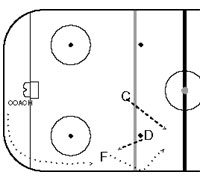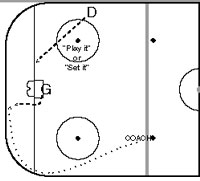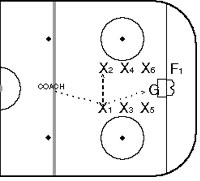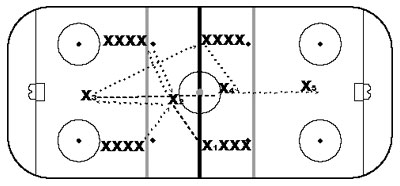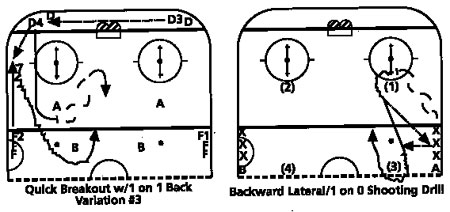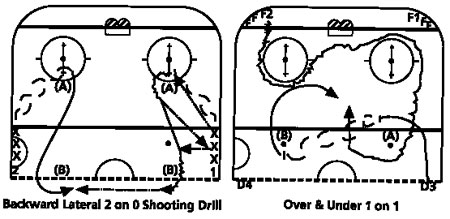Half-ice, full-impact drills
By Bob Destocki
Oct 31, 2001, 16:47
As an instructor and lecturer at hockey schools and seminars, the thing most people want to talk to me about—and learn—are drills. It seems that coaches and players at all levels are always interested in new drills.
Sometimes on long airplane flights, I find myself doodling around with a drill. Breaking it down and putting it back together, seeing if I can find a different way to accomplish the purpose of the drill. I remember the first Russian drill I got from the late Fred Shero—who himself picked it up from the Soviet hockey innovator Anatoli Tarasov—was drawn on a cocktail napkin!
Half-ice drills are always a hot topic among youth-hockey coaches, since they usually practice in a shared-ice situation. Here are a few drills that can be done on half-ice.
Quick Breakout with 1-on-1 Back
Just about every coach does at least one checking drill during a practice. This drill is good to use anytime, but especially if breaking out is the theme of your practice. It teaches the cornerstone of good breakout technique—the quick outlet pass—as well as attack and defend principles.
Split the forwards and defense evenly on each side of the ice. Line the forwards (1 & 2) along the boards, facing the opposite end of the rink. The first forward in each line starts at the hash-marks. Give your defensemen (3 & 4) pucks and line them up behind the goal line in each corner. You will need four pylons for this drill; two placed five feet inside the blue line (A), and the others placed five feet inside the centerline (B).
The drill starts with defenseman 3 skating around the back of his net with the puck, and making a breakout pass to forward 2. Forward 2 skates out of the zone, around pylon B, and attacks the net. After making the pass, defenseman 3 skates out and pivots around pylon A where he defends against attacking forward 2. The next sequence starts, on the coach’s whistle, exactly the same way with defenseman 4 and forward 1.
Variations
Line the forwards (1 & 2) up at the blueline, facing the attacking net. The forwards break down the boards and set up on the hash-marks or top of the circles. Defensemen (3 & 4) line up in the same way, but instead of going around the net, they stop behind the net and come back out on the same the side they started from. The sequence is now 3-vs.-1 followed by 4-vs.-2.
If you want to practice your D-to-D passes, start with one defenseman (3) passing to the other (4), then continue the drill (4-vs.-2). In this sequence defenseman 4 does not go behind the net; he passes out from his corner.
To teach the defensemen good body positioning, I sometimes run this drill with the checking defensemen playing without a stick. You must utilize both defensemen in this variation, one is the passer and the other is the checker. Defenseman 3 passes to 1, while 4 skates around the pylon without a stick and defends against 1.
Teaching Points
Name your drills so your players will remember them. All drills should be done with 100% effort (50% on initial introduction), and each sequence starts and stops on the coach’s whistle.
Forwards:
• Breakout position, one skate and lower body against the boards, stick on the ice.
• Head up when skating with the puck, read the defender when attacking the net.
• Accelerate on crossover turns around the pylons and attack with speed.
• Use the defender as a screen, if possible.
• Always get a shot off and go for the rebound.
Defensemen:
• Move the puck out quickly with crisp, short, accurate passes.
• Quick pivots around pylons.
• Face attacker, stick on the ice ready for poke check.
• Align your inside shoulder with the attacker’s outside shoulder.
• If the attacker shoots, keep him away from any rebound.
Backward Lateral 1-on-0 Shooting Drill
This is a good shooting drill that incorporates backward lateral skating with a give-and-go pass. It helps develop puck handling while skating backward laterals (especially good for defensemen).
Divide your team into two groups (1 & 2) on each side of the ice along the boards, at the blueline, facing the net. Again, you will need 4 pylons for this drill. Position pylons A and B about 15 feet from the boards at the top of the faceoff circles, and pylons C and D on the red line at the faceoff dots. On the coach’s whistle, player 1 skates backward-lateral with puck around pylon A. After rounding the pylon he then skates forward and passes to the next man in line 1, who passes the puck back to him (give-and-go), he continues with forward lateral crossovers around pylon C and attacks the net. As player 1 rounds pylon C, the coach whistles player 2 to start the sequence from the other side, and so on.
Variations
To stress puck movement, add a third pass. Player 1 starts without the puck. As he rounds pylon A, the next player in line passes him the puck; he passes it back and receives the return pass.
After your players have mastered the three-pass variation, add a fourth pass. This sequence starts the same as the three-pass variation, except now player 2 starts at the same time as player 1 who, having received the third pass, now skates toward pylon D. Player 2 skates toward pylon C without the puck. Player 1 passes to player 2 in the center ice area. Both players 1 and 2 continue wide around pylons C and D and attack the net 2-on-0.
Teaching Points
The coach must control the drill sequences with whistle starts and stops to avoid collisions and pace the goaltender.
• Stickhandling the puck with head up while skating backward laterals.
• Always pass moving forward, not backward.
• Accelerate on crossover turns around the pylons, and attack with speed.
• During 2-on-0, stress wide attack by skating around opposite pylons.
Over and Under 1-on-1
This is a very good agility drill to teach quick feet, and using your edges. The players must be fairly good skaters to do this drill, because it involves lots of turns and pivots.
Split the forwards and defensemen evenly on each side of the ice. Line the forwards (1 & 2) up behind the goal line in each corner, facing the opposite end of the rink. Position your defensemen (3 & 4) along each board at center ice, facing their own net. You will need 2 pylons for this drill, placed on the blueline at the faceoff dots. The drill begins on the coach’s whistle with forward 2 and defenseman 3 starting simultaneously. Forward 2, with the puck, skates over the faceoff circle closest to him and under the opposite faceoff circle. Heading up ice, he turns around pylon A and attacks the net. Defenseman 3 skates forward toward pylon A, as he rounds it he pivots backwards and skates backwards across the ice toward pylon B. As he rounds pylon B he pivots again to forward skating and defends against forward 2, who is attacking the net. The next sequence starts on the coach’s whistle exactly the same way, with forward 1 and defenseman 4.
Variations
To stress puck movement, forward passes to next defenseman in line and receives return pass (give-and-go). Another variation: defenseman 3 starts with puck, forward 2 without. As defenseman rounds pylon B he passes to the forward rounding pylon A and defends 1-on-1.
Teaching Points
Coach must control the drill sequences with whistle starts and stops.
Forwards:
• Must skate over and under circles with constant crossovers.
• Always keep head up and maintain control of the puck while skating over and unders.
• Accelerate on crossover turns around the pylons and attack with speed.
• Use defender as screen, if possible.
• Always get a shot off and drive for rebound.
Defensemen:
• Move feet quickly.
• While pivoting, maintain good body control.
• Face attacker, stick on the ice, ready for pokecheck.
• Align your inside shoulder with the attacker’s outside shoulder.
• If the attacker shoots, keep him away from any rebound.
A final point: Drills must always have a purpose, and should not be done just to fill time. They should relate to each other and be connected to the overall goal of your practice. Players don’t like to waste time; coaches shouldn’t either.
Bob Destocki is a partner of the Huntington Blizzard Hockey Club of the ECHL.
This first appeared in the 09/1995 issue of Hockey Player Magazine®
© Copyright 1991-2001 Hockey Player® and Hockey Player Magazine®








